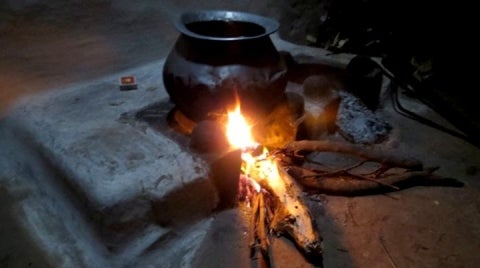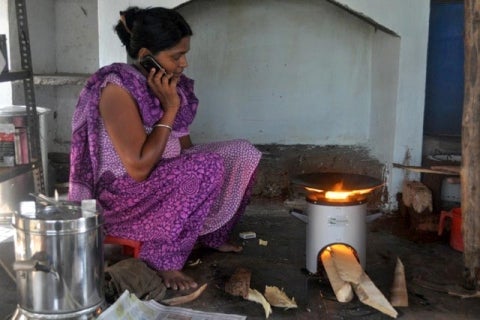Note: Yale School of the Environment (YSE) was formerly known as the Yale School of Forestry & Environmental Studies (F&ES). News articles and events posted prior to July 1, 2020 refer to the School's name at that time.
 Traditional cookstoves produce about one-fifth of all black carbon emissions worldwide.
Traditional cookstoves produce about one-fifth of all black carbon emissions worldwide.
More than 3 billion people worldwide still rely on the burning of wood, plant matter and other waste materials for cooking and indoor warmth, emitting sooty pollution that causes an estimated 4 million premature deaths annually and exacerbates global climate change.
And while a variety of cleaner, low-cost cookstove alternatives have emerged over the last decade, adoption in many parts of the developing world remains slow.
Beginning this summer, a team of researchers led by Robert Bailis of the Yale School of Forestry & Environmental Studies will conduct a three-year study to assess which cookstove technologies are most likely to be accepted by local communities in India, obstacles to their adoption, and the potential health and climate benefits of widespread use.
And while a variety of cleaner, low-cost cookstove alternatives have emerged over the last decade, adoption in many parts of the developing world remains slow.
Beginning this summer, a team of researchers led by Robert Bailis of the Yale School of Forestry & Environmental Studies will conduct a three-year study to assess which cookstove technologies are most likely to be accepted by local communities in India, obstacles to their adoption, and the potential health and climate benefits of widespread use.
Hopefully we'll be able to learn more about the conditions that will encourage people to incorporate these improved, robust technologies into their daily lives.
The U.S. Environmental Protection Agency (EPA) on Wednesday announced a $1.5 million grant to support the project under the agency’s “Science to Achieve Results” (STAR) research program.
“There has been a technical renaissance in cookstove technology in recent years, but the adoption of these stoves is not where we would like it to be,” Bailis said. “Hopefully we'll be able to learn more about the conditions that will encourage people to incorporate these improved, robust technologies into their daily lives.”
The project will also include researchers from North Carolina State University, the Universities of Minnesota, Georgia, and British Colombia, and two non-governmental organizations in India.
For the study, researchers will distribute one of several different cooking alternatives — including cleaner wood-burning stoves, gas-powered stoves, and electric stoves — to households in eight communities across two Indian states. They are hoping to include 200 homes per community, in addition to 50 control sites.
To assess the potential success of different intervention options, some households will receive the stoves free of charge while others will be charged a small fee.
In addition, about half of the participating households will be allowed to try different models every few months. By allowing that flexibility, Bailis said, it might provide insights into whether participants are willing to be more experimental if they do not feel tied to a particular model of stove.
“For us, if we buy something at Target or on Amazon, we know there is no risk — or the only risk is that we’ll have to run it back or return it,” Bailis said. “We hope that by introducing this option for a switch-out that we’ll see greater adoption because people will be a little more open to risk-taking.”
“There has been a technical renaissance in cookstove technology in recent years, but the adoption of these stoves is not where we would like it to be,” Bailis said. “Hopefully we'll be able to learn more about the conditions that will encourage people to incorporate these improved, robust technologies into their daily lives.”
The project will also include researchers from North Carolina State University, the Universities of Minnesota, Georgia, and British Colombia, and two non-governmental organizations in India.
For the study, researchers will distribute one of several different cooking alternatives — including cleaner wood-burning stoves, gas-powered stoves, and electric stoves — to households in eight communities across two Indian states. They are hoping to include 200 homes per community, in addition to 50 control sites.
To assess the potential success of different intervention options, some households will receive the stoves free of charge while others will be charged a small fee.
In addition, about half of the participating households will be allowed to try different models every few months. By allowing that flexibility, Bailis said, it might provide insights into whether participants are willing to be more experimental if they do not feel tied to a particular model of stove.
“For us, if we buy something at Target or on Amazon, we know there is no risk — or the only risk is that we’ll have to run it back or return it,” Bailis said. “We hope that by introducing this option for a switch-out that we’ll see greater adoption because people will be a little more open to risk-taking.”

Those participants who are allowed to try multiple alternatives will be asked to share their feedback on the different technologies during a series of focus group-like discussions.
And throughout the project, researchers will measure indoor and outdoor particulate matter levels to gauge the potential health impacts of widespread technology adoption.
Traditional cookstoves are a major source of black carbon aerosols, producing one-fifth of all black carbon emissions worldwide, according to the EPA. The household air pollution created by cookstoves is the fourth-biggest cause of illness and death worldwide.
Four other universities will also receive funding for separate projects as part of the EPA initiative.
“These EPA-funded research teams are taking incredible steps to protect public health and the environment by looking into cleaner technologies for cooking, lighting, and heating,” said Jim Johnson, director of EPA’s National Center for Environmental Research.
“Not only will they look at better ways to measure and track pollution, but also look at the socio-economic and cultural elements of different communities when it comes to integrating new cookstove and biofuel technologies.”
And throughout the project, researchers will measure indoor and outdoor particulate matter levels to gauge the potential health impacts of widespread technology adoption.
Traditional cookstoves are a major source of black carbon aerosols, producing one-fifth of all black carbon emissions worldwide, according to the EPA. The household air pollution created by cookstoves is the fourth-biggest cause of illness and death worldwide.
Four other universities will also receive funding for separate projects as part of the EPA initiative.
“These EPA-funded research teams are taking incredible steps to protect public health and the environment by looking into cleaner technologies for cooking, lighting, and heating,” said Jim Johnson, director of EPA’s National Center for Environmental Research.
“Not only will they look at better ways to measure and track pollution, but also look at the socio-economic and cultural elements of different communities when it comes to integrating new cookstove and biofuel technologies.”
– Kevin Dennehy kevin.dennehy@yale.edu 203 436-4842
Published
May 28, 2014